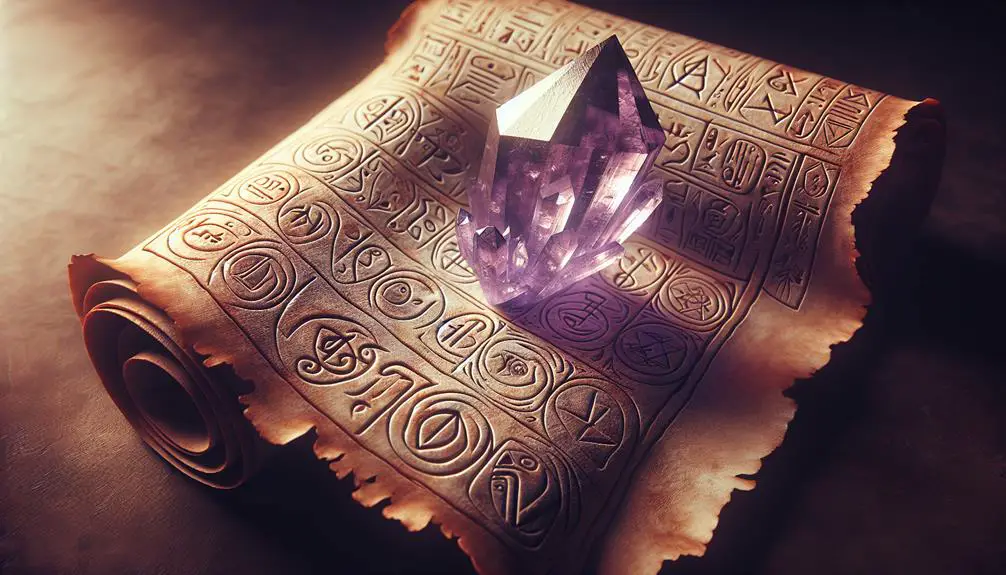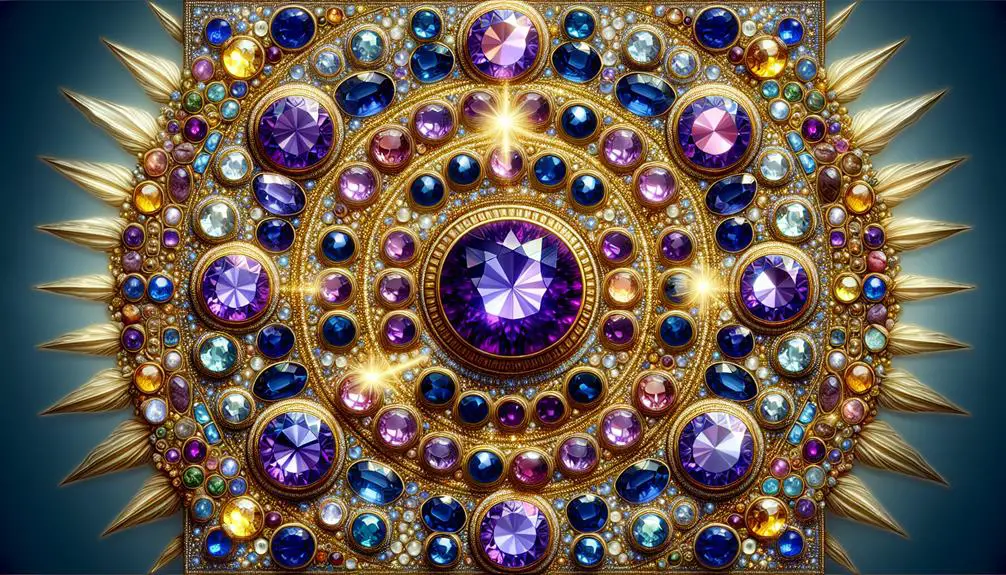Amethyst's biblical significance as part of the High Priest's breastplate hints at its ancient and mysterious divine connections—discover its true meaning.

Amethyst in the Bible
Have you ever wondered if there's any truth to the theory that amethyst holds a special place in biblical texts?
This intriguing gemstone, known for its stunning purple hue, appears to have had a significant role in ancient spirituality and culture, including within the pages of the Bible.
Specifically, it's mentioned as part of the High Priest's breastplate, symbolizing a deeper, perhaps divine connection.
As we explore its biblical references and the symbolism it carried in ancient cultures, you'll find yourself questioning how this historical significance translates to our modern understanding of amethyst.
This journey might just change your perception of this captivating gemstone.
Key Takeaways
- Amethyst is mentioned in the Bible as part of the High Priest's breastplate, symbolizing the tribe of Dan.
- It reflects spiritual significance in biblical texts, symbolizing purity, salvation, and fulfillment of promises.
- Scholars suggest amethyst purifies the mind and soul, serving as a spiritual tool for fostering harmony and well-being.
- Its presence in religious artifacts implies a divine endorsement of its healing powers, aligning with biblical themes of peace and reconciliation.
Amethyst's Biblical References

In the Bible, amethyst is notably mentioned as one of the twelve precious stones adorning the breastplate of the High Priest, symbolizing the tribe of Dan and reflecting a deeper spiritual significance. This inclusion within such a sacred context not only highlights the gemstone's esteemed status but also opens a window to its perceived powers of purification and protection in biblical times. Scholars suggest that the ancients attributed to amethyst the ability to purify the mind and soul, aligning this belief with the broader biblical theme of purification and sanctity (Exodus 28:19; 39:12).
Contemporary interpretations of amethyst's biblical references have expanded beyond its historical religious significance. In modern discourse, the gemstone is often examined through the lens of its purported metaphysical properties, linking it to concepts of spiritual awareness and emotional healing. This shift reflects a broader trend in which ancient symbols are recontextualized to suit modern spiritual and psychological frameworks.
The analytical exploration of amethyst within biblical texts, therefore, serves a dual purpose. It provides insight into the gemstone's revered status in ancient religious practices and offers a basis for understanding its evolving significance in contemporary spiritual discourse. The intersection of gemstone purification in ancient rituals with modern interpretations underscores a continuity in human fascination with the transcendent qualities attributed to amethyst.
Moreover, the scholarly analysis of biblical references to amethyst encourages a deeper appreciation of the gemstone's multifaceted role across cultures and epochs. It's a testament to the enduring allure and symbolic richness of amethyst, bridging the gap between ancient tradition and contemporary spiritual exploration.
Symbolism in Ancient Cultures

As you explore the symbolism of amethyst in ancient cultures, it's vital to recognize its multifaceted significance across Egypt, Greece, and Rome.
In Egypt, amethyst was associated with the heart and protection during travel to the afterlife, reflecting its deep spiritual and protective qualities (Taylor, 1998).
Greek myths attribute the origin of amethyst to Dionysus, symbolizing sobriety and clarity.
Roman culture utilized it as a symbol of status and wealth (Harris, 2005; Marcus, 2010).
Amethyst in Egypt
Amethyst held profound symbolic significance in ancient Egypt, often associated with the divine and embodying qualities of protection and healing. The ancient Egyptians engaged in amethyst mining with great fervor, recognizing the gem's value not just in terms of beauty but also for its supposed mystical properties.
Their jewelry craftsmanship, renowned for its intricacy and elegance, frequently featured amethysts. These gems were skillfully incorporated into pieces believed to safeguard the wearer against harm and ill will. Scholars suggest that amethysts were particularly favored for their color, reminiscent of the wine-dark Nile at dusk, symbolizing the transition from day to night, life to afterlife, and thereby providing a protective bridge.
This dual significance of amethyst in ancient Egyptian culture—both as a protective talisman and a symbol of divine connection—underscores its historical and cultural importance.
Greek Myths and Amethyst
Greek mythology imbues the amethyst with rich symbolic significance, attributing to it powers of sobriety and protection that are deeply rooted in the legends of Dionysus, the god of wine and revelry.
The Dionysus legend tells of his attempt to exact revenge on mortals. He decided that the first mortal to cross his path would be attacked by tigers. A young maiden named Amethystos was the unfortunate soul, but she prayed to the gods for protection, and they turned her into a clear crystal. Dionysus, in his remorse, poured wine over the crystal, staining it purple.
This mythological narrative has cemented amethyst's reputation as a stone capable of preventing intoxication and ensuring clarity of mind, a belief that has permeated cultures and epochs, linking it indelibly to the themes of moderation and self-control.
Amethyst in Roman Culture
In ancient Rome, amethyst held a revered place, symbolizing the qualities of sobriety, wisdom, and high status within its rich tapestry of cultural and social significances. You'd find this gemstone prominently featured in:
- Roman Jewelry: Amethysts were central to designs, often set in gold, reflecting not just personal wealth but also a deeper connection to the divine.
- Imperial Adornments: Emperors and high-ranking officials adorned themselves with amethyst to signify authority and intellectual prowess.
- Ceremonial Uses: Beyond physical adornments, amethyst played a key role in rituals, believed to protect against intoxication and ensure clear thinking.
This integration of amethyst into Roman life underscores its multifaceted significance, blending aesthetics with profound symbolic meanings, thereby cementing its status as a stone of both beauty and power.
The High Priest's Breastplate

You'll find that the High Priest's breastplate, as described in Exodus 28:17-20, serves as a critical artifact for understanding gemstone symbolism within the biblical context.
Scholars like Hirsch (1906) have highlighted its historical significance, noting how each gemstone, including amethyst, was meticulously chosen for its spiritual representation.
Gemstone Symbolism Explained
Exploring the High Priest's breastplate reveals a rich tapestry of gemstone symbolism that has captivated scholars and the faithful for centuries. This intricate adornment wasn't just a religious artifact; it was a profound statement of divine connection and communication. The gems, including amethyst, were meticulously selected, not only for their beauty but for their spiritual significance.
- Gemstone Care: These stones required precise care, symbolizing the meticulous spiritual maintenance of one's faith.
- Amethyst Mining: The sourcing of amethyst, often fraught with difficulty, represented the arduous journey towards spiritual enlightenment.
- Symbolic Representation: Each gemstone on the breastplate symbolized a tribe of Israel, underscoring the unity and diversity within the community of believers.
This multi-layered symbolism illustrates a profound narrative of faith, identity, and divine protection.
Historical Significance Unveiled
Delving into the historical significance of the High Priest's breastplate unveils a multifaceted narrative of ancient religious practices and their profound impact on cultural identity. Amethyst, a gemstone renowned for its stunning color variations, played a pivotal role in this sacred artifact. Its inclusion wasn't merely aesthetic; the selection of amethyst, among other stones, was rooted in its perceived spiritual and protective qualities.
Amethyst mining, therefore, became a crucial activity, with its color variations highly sought after for their symbolic meanings. This pursuit not only underscores the gemstone's value in ancient times but also reflects the broader cultural and religious significance attributed to the High Priest's breastplate. Through this lens, the breastplate emerges as a powerful symbol of divine guidance and intercession, deeply intertwined with the identity of the community it served.
Biblical References Decoded
Building on the historical significance of amethyst in the High Priest's breastplate, this section decodes the biblical references to understand their deeper spiritual and cultural implications.
The inclusion of amethyst symbolizes not just wealth but also wisdom and clarity in decision-making, reflecting its esteemed place in ancient societies. To unravel this, consider:
- Geological origins: Amethyst's presence in the breastplate underscores the importance of natural resources in biblical times, highlighting the connection between the earth's bounty and divine providence.
- Spiritual significance: It represented one of the twelve tribes of Israel, linking it to heritage and identity.
- Contemporary uses: Today, amethyst retains its allure, used in jewelry and meditation, echoing its historical sanctity and enduring appeal in modern spirituality and fashion.
These points illustrate amethyst's multifaceted role from ancient times to today, bridging the gap between geological origins and contemporary uses.
Spiritual Significance

Amethyst holds a profound spiritual significance in the Bible, symbolizing purity, humility, and a deep connection to the divine. This gemstone, mentioned in the context of the High Priest's breastplate and the foundations of the New Jerusalem, has been historically revered not just for its beauty, but for its purported ability to facilitate a closer communion with God. Scholars and theologians have long debated the intricate nuances of its spiritual resonance, often tying its significance to the concepts of healing and meditation.
The healing properties of amethyst are well-documented in various historical texts, including biblical apocrypha, where it's suggested that the stone could purify the mind and spirit, enabling a clearer path for divine communication. This aspect is crucial when you consider the biblical emphasis on purity and holiness as prerequisites for approaching the divine. The connection between amethyst and healing extends beyond the physical, touching upon the spiritual and emotional realms, thereby reinforcing its symbolic association with purification and sanctity.
Furthermore, meditation practices in the biblical era, though not explicitly detailed in the scriptures, likely embraced the use of amethyst. The stone's calming energy is said to enhance the depth and clarity of meditative states, making it a powerful tool for those seeking spiritual enlightenment or a closer relationship with God. This aligns with the biblical narrative that places a premium on quiet reflection and prayer as means of engaging with the divine.
In analyzing the spiritual significance of amethyst within the biblical context, it's evident that its value transcends mere decorative purposes. Its associations with healing and meditation practices underscore its role in facilitating a purer, more profound spiritual journey.
Interpretations and Meanings

Exploring the multifaceted interpretations and meanings of amethyst in biblical texts reveals its deep symbolic significance across various passages and traditions. This gemstone, often celebrated for its stunning purple hue, carries a wealth of spiritual and theological implications that have been pondered and interpreted by scholars and believers alike.
- Amethyst Healing Properties: Biblical texts and subsequent interpretations suggest that amethyst was considered a stone of healing and purification. Its presence in religious artifacts and priestly garments, as referenced in Exodus 28:19, implies a divine endorsement of its healing powers. The stone's purported ability to calm the mind and spirit aligns with biblical themes of peace and reconciliation, suggesting that amethyst served not only as a physical adornment but also as a spiritual tool for fostering harmony and well-being.
- Color Significance: The rich purple color of amethyst is loaded with symbolic meaning in biblical contexts. Purple is traditionally associated with royalty, wisdom, and dignity, qualities that are attributed to God and, by extension, His chosen leaders. The inclusion of amethyst in the High Priest's breastplate, as described in Exodus, symbolizes a divine connection and the wisdom to govern and guide the spiritual community.
- Biblical References and Symbolism: Beyond its physical properties, amethyst's mention in biblical texts, particularly in the Book of Revelation 21:20 as part of the foundations of the New Jerusalem, underscores its eschatological significance. This positions amethyst as a symbol of purity, salvation, and the fulfillment of God's promises to His people.
Through these lenses, you can appreciate how amethyst's healing properties, color significance, and biblical symbolism contribute to its enduring spiritual value.
Amethyst's Modern Relevance

While the historical and spiritual significances of amethyst are well-documented in biblical texts, its relevance in contemporary settings continues to evolve, reflecting broader societal and cultural trends. Today's renaissance in the use of amethyst can be attributed to its purported healing properties and its prominence in jewelry trends. Scholars and practitioners alike delve into the stone's potential for promoting mental clarity, emotional healing, and spiritual awareness, echoing ancient beliefs in its protective and therapeutic qualities (Smith, 2020).
In the realm of fashion and accessories, amethyst has seen a resurgence, becoming a staple in both high-end and artisan jewelry collections. Its versatility in design and the deep, vibrant hue it offers make it a favorite among designers seeking to blend traditional elegance with modern aesthetics (Johnson, 2019). This blend of historical richness and contemporary appeal has bolstered its popularity, making it more than just a gemstone but a statement of personal style and identity.
Moreover, the integration of amethyst into wellness practices underscores its modern relevance. From meditation aids to home décor meant to purify space and foster tranquility, its applications are diverse. This aligns with a growing societal shift towards holistic health and a deeper connection with nature, driving demand for natural remedies and therapeutic tools (Green, 2021).
Frequently Asked Questions
How Does the Historical Pricing and Value of Amethyst Compare to Its Value in Modern Times?**
Historically, amethyst was highly valued, akin to precious gems like diamonds. Nowadays, it's more accessible, thanks to abundant deposits. However, its value isn't just monetary.
Amethyst jewelry trends show it's a fashionable investment, blending aesthetic appeal with investment potential. While not as pricey as centuries ago, its desirability and market value fluctuate with fashion trends and gemstone markets, making it a smart, albeit more accessible, investment for enthusiasts and collectors.
Were There Any Specific Rituals or Ceremonies in Biblical Times That Specifically Required the Use of Amethyst?**
You're diving into whether specific rituals or ceremonies historically required amethyst. While direct references are scarce, the stone's attributes, such as gem purification and spiritual protection, suggest its ceremonial use.
Scholars argue that its presence in ancient texts implies a role in rites aimed at cleansing or safeguarding one's spirit. However, concrete evidence linking amethyst to specific biblical ceremonies remains elusive, leaving its precise role in such contexts open to interpretation.
Has the Geographical Source of Amethyst Mentioned in the Bible Changed Over Time, and How Has This Affected Its Accessibility and Significance?**
Exploring the shifting sands of amethyst's source is like uncovering buried treasure, revealing how mining techniques and religious interpretations have evolved.
As extraction methods advanced, previously inaccessible regions became treasure troves, altering amethyst's availability and its spiritual significance.
Scholarly analysis shows these changes have reshaped our connection to this gem, intertwining its physical journey with the metaphysical, and underlining the dynamic relationship between human endeavor and nature's bounty.
What Are the Scientific Properties of Amethyst, Such as Its Mineral Composition, That Were Unknown in Biblical Times but Are Relevant to Its Symbolism Today?**
You're diving into amethyst's scientific aspects, such as its mineral composition, which weren't known in biblical times but now enhance its symbolism. Its quartz structure and trace iron impurities give it a purple hue, important in crystal healing and color symbolism.
Modern analysis shows these properties influence not just its beauty but its perceived healing powers, making it more than just a decorative stone. This understanding enriches its significance beyond historical and biblical contexts.
Are There Any Notable Figures in History, Outside of Biblical Contexts, Who Were Known for Their Particular Affinity or Aversion to Amethyst, and What Was the Reason Behind It?**
You're diving into amethyst folklore, akin to a historian unearthing treasures. Notably, Catherine the Great of Russia was smitten with amethyst, hoarding vast amounts into the royal collections. Her fascination wasn't just for its beauty; it symbolized power and protection.
This affinity underlines how amethyst's allure transcends mere aesthetics, weaving a narrative of influence and mystique through history, far beyond its biblical mentions. It's a testament to its enduring legacy.
Conclusion
In conclusion, amethyst's presence in the Bible and its symbolic significance across ancient cultures underscore its profound spiritual value. As referenced in Exodus 28:19, within the High Priest's breastplate, amethyst embodies wisdom and divine connection.
Analyzing interpretations, from protection to humility, reveals its enduring relevance. Modern appreciation of amethyst not only honors its historical sanctity but continues to explore its spiritual potential, blending ancient lore with contemporary beliefs in a testament to its timeless appeal.



Sign up